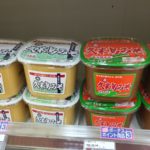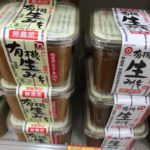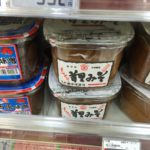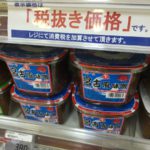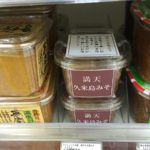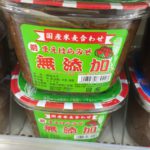Previously I made a post about a special type of miso found in Okinawa, called andansu. But this is not the only miso you will find, as you can find all the regular Japanese varieties of miso as well. Sometimes you can find locally produced miso, and other brands will be big nation-wide corporate brands (not necessarily a bad thing). So let’s take a look at some of the things you should know about finding the right miso for you in Okinawa.
To start, things to look for on the label:
White miso 白みそ: this is a “light” or mild miso.
Blended Miso (Awase miso) 合わせみそ: this is usually pretty versatile and the one I typically keep in my fridge.
Red Miso 赤みそ: this is usually dark and salty, but so good. My husband prefers this darker, saltier miso but it can be pungent if you are not used to it.
dashi (fish broth) added だし入り: you probably don’t want this. It is so much easier to add your own dashi (and you can make it vegan by using konbu/seaweed dashi) and adjust it to your tastes.
organic 有機
additive-free 無添加
reduced salt 減塩
Special Notes:
*for non-GMO, if you look at the ingredient list, and the soybeans 大豆 are from Japan 国産 then you know it is non-GMO. Otherwise, it probably will not say.
*for gluten-free, check to see if 麦 (barley) or 小麦 (wheat) are listed in the ingredients.
*for soy-free (I know… sounds crazy right?), read this previous post I made about finding soy-free foods in the grocery store.
Now, where do I get miso? Well, any grocery store has an entire aisle dedicated to it. The choices are, frankly, overwhelming. It might take a few tries until you find one perfect to your tastes and uses. Look for ones that say 沖縄県産 for brands local to Okinawa; some examples you can find easily in stores are Kumejima miso 久米島みそ, Shuri miso 首里みそ, and Shimagome miso 島米みそ. Other big brands like Marusan, Marukome, TopValu, Maruman, etc. are also commonly found in stores here. I usually don’t go for these, but out of all the big brands, I think Hikari 光 is probably one of the best in my opinion (I don’t have a picture, but it comes in many varieties depending on your preference and says HIKARI on the tubs).
There is a lovely place I went to in the southern part of the island, you can read about it here: Miso chiffon cake, Yume Koubou: 菊みそ加工所夢工房. I bought some of their miso and it was really good, and while not the cheapest, reasonably priced I thought.
There is also a specialty store in the Aeon Rycom Mall, called Kuze Fuku, and they often have many varieties of higher-end miso and specialty miso from different areas of Japan. I recommend checking here if you are looking for something “special.”
Sometimes farmers markets will have bags of homemade miso, usually pretty cheap.
Below are some examples of miso you can find in Okinawa stores:
This is just some info focusing on Okinawa. For a much more comprehensive and explanatory look at miso, as well as some ways to cook with it, I highly recommend reading JustHungry website’s Miso Primer. It is such an excellent resource, I always recommend it to anyone who is first starting out with miso.
